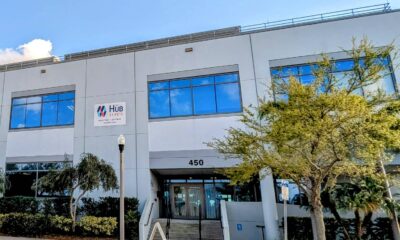Thrive
Clearwater debates development moratorium due to U.S. 19 concerns

Construction of new residential units along the U.S. 19 corridor continues to soar as mixed-use developments lag far behind, leading the Clearwater City Council to discuss a development moratorium in hopes of addressing the issue.
Clearwater Mayor Frank Hibbard called a special work session Monday morning in response to development along the U.S. 19 corridor deviating from guidelines in the city’s redevelopment plan. The fear is that the preponderance of new residential construction decreases the supply of larger redevelopment sites for mixed-use and employment generating applications.
Hubbard noted the effort that went into creating the U.S. 19 Corridor Redevelopment Plan but said at some point, the city needs to reassess if the plan is working. He said the city is not currently seeing the development patterns it hoped would occur.
“We’re seeing a lot of storage units, we’re seeing a lot of standalone apartment complexes,” said Hibbard. “We hoped for more mixed-use, more work, live, play – all in the same location.”
Hibbard relayed how Clearwater lost the Heritage Insurance company late last year, which needed a 100,000 square-foot facility for a new corporate headquarters. Hibbard said the city could not provide the space, and the company moved to the Westshore area of Tampa. That loss of local jobs prompted Hibbard to broach the topic of a development moratorium.
Gina Clayton, director of planning and development for the city, began the presentation on the status of the U.S. 19 corridor. She explained that after several years of planning and research, the city adopted the U.S. 19 Zoning District and Development Standards in 2017, which rezoned a seven-mile corridor along the highway.
The U.S. 19 District is over 1,600 acres, consisting of around 4,600 parcels. While the emphasis was on creating employment-intensive development, that type of growth has failed to meet expectations.
“We’re just finding right now that our market is not ready to support offices at this time,” said Clayton.
While city officials are concerned about the number of new residential units far outpacing the amount of available office space and mixed-use development, Clayton said those residential units are needed to keep up with population growth. According to Clearwater’s 2040 population projection, the city needs 4,800 additional housing units to meet demand.
“If you look at what’s being built now on U.S. 19 and you subtract those out, the city is still going to need about 2,800 additional housing units,” said Clayton.
She said the “bottom line” as to why the city struggles to attract employment-intensive development is that housing and storage unit developers can pay more for the best sites. Clayton said planning and development staff agree with the mayor on the need for more mixed-use development, but the market must also support the initiative.
Clayton added that new housing typically spurs growth in the retail and service industries, leading to a job increase in those sectors.
“The process takes time,” she said. “I know we have to be patient.”
Clayton said the concern with city staff is that a moratorium would push future developments to other areas. She noted the City of Largo’s plans for redevelopment along the U.S. 19 corridor, and suggested the city’s market is ripe for growth.
Denise Sanderson, director of economic development and housing, said an ad valorem tax exemption could help bring the type of growth the city hopes to see along the corridor. She also believes focusing on placemaking and offering incentives could help lure mixed-use developers.
“The greatest challenge in attracting development is surety and predictability within the marketplace,” said Sanderson. “And I think conversations like this are a little bit frightening.”
Sanderson said education throughout the community is also needed as many citizens believe Clearwater is strictly a tourist city. She said many residents believe places like St. Petersburg and Tampa are better suited for the jobs Clearwater hopes to attract. She called those comments “eye-opening” and said they illustrate the need for education on the value of high-quality jobs in the area.
Hibbard asked why Sanderson thought these conversations were frightening, and she replied that broaching the subject of a moratorium causes immediate concern for all developers. She added that it takes a long time to rebuild a reputation with developers once you remove that surety and predictability.
“Well, we wouldn’t have had this conversation at all had I not raised a moratorium,” replied Hibbard. “So, I think it was productive, and I am not frightened by it one little bit.”
Councilmember Hoyt Hamilton said that a moratorium would only postpone the inevitable development of more apartments. He said that while many city leaders are opposed to the storage facilities in the corridor, they are a necessity in an area experiencing an influx of new residents from other parts of the country.
Hamilton said these issues were not foreseeable when the city created the U.S. 19 Corridor Redevelopment plan, and the lack of greenspace hurts the city’s best efforts to create mixed-use developments.
“We’re a fully developed city,” said Hamilton. “Largo still has some greenspace – we don’t. It’s a different game.”
Hibbard ultimately said he sees a way forward without enacting an unpopular moratorium. He credited city staff for coming up with potential solutions, such as utilizing business incentives, targeted advertising and placemaking. Hubbard said he believes that the market will ultimately correct itself but did note the city’s disadvantage due to a lack of green space.
“We do have special incentives throughout this city that you have voted for, and so I think it is appropriate sometimes to sweeten the pot, so to speak,” Hibbard told the council. “For the right kind of development that is going to improve the overall environment in the city.”








Bob Larrivee
February 1, 2022at4:37 pm
It is about time. The county should do the same for unincorporated Pinellas.
Karl Nurse
January 31, 2022at4:30 pm
I remember when we required the ground floor of downtown St Pete new buildings have active retail/office space. This was around 2000. The multi-family developers complained until the discovered that it increased their profits and added to ease at selling the units. Downtown St Pete works significantly because it works for folks walking.
If you want a moratorium, nothing contributes less to a community than shortage units. Limit them.